In this article, we delve into the tactical approach of England’s national football team under the management of Gareth Southgate. Known for his meticulous planning and strategic understanding, Southgate has transformed England into a formidable force on the international stage. This analysis explores the key principles, formations, and player roles that define Southgate’s England, providing insights into how his tactics have shaped the team’s successes and challenges. Join us as we break down the tactical nuances that underpin England’s performances and highlight the strategies that have made Gareth Southgate one of the most successful England managers in modern history.
Build-up
Low Build-up
In the low build-up, Southgate sets his team up in a 1-4-2-3-1 formation, with a back four, a double pivot, one number-ten with two wingers outside, and Kane as the striker upfront.
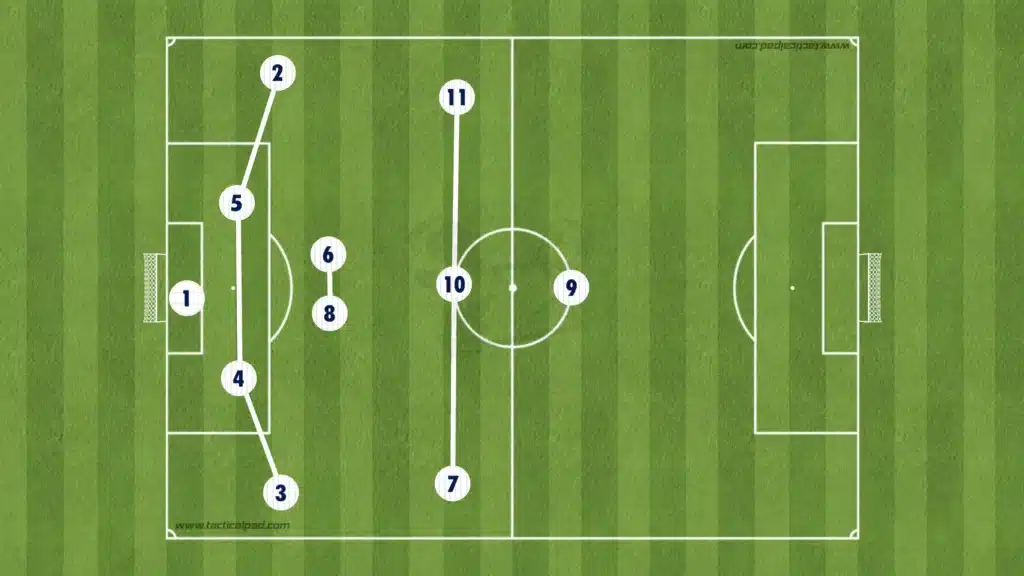
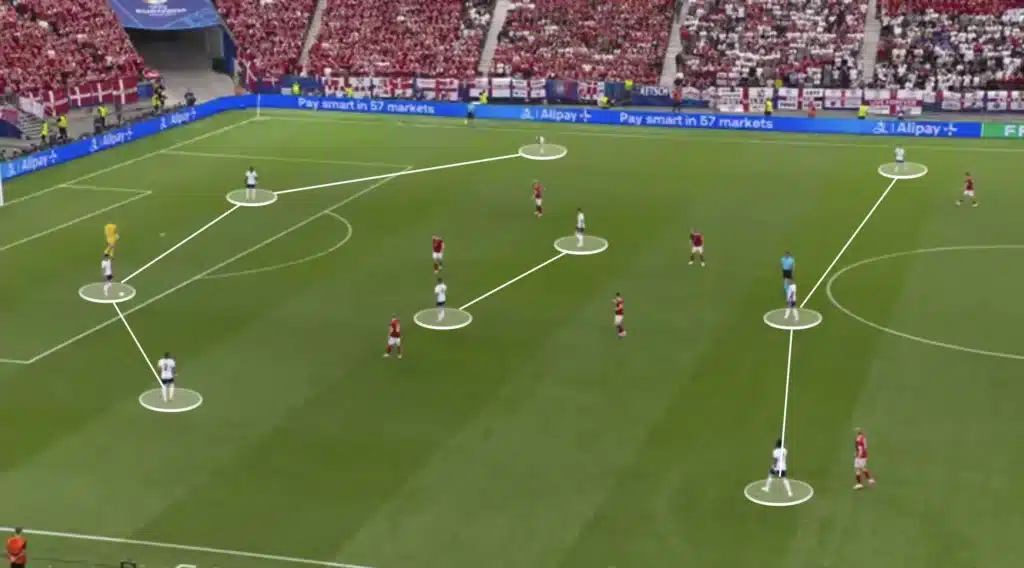
The wingers and number-ten often drop in the low build-up, trying to create numerical advantages, allowing England to play through the press. If the opposition follows the dropping England players, Kane will be left in a 1v1 against the opposition center-back, which he often will win.
High Build-up
In the high build-up, Southgate changes the formation to a 1-3-2-2-3 formation, with a back three, two holding midfielders, two attacking midfielders, and three up front.
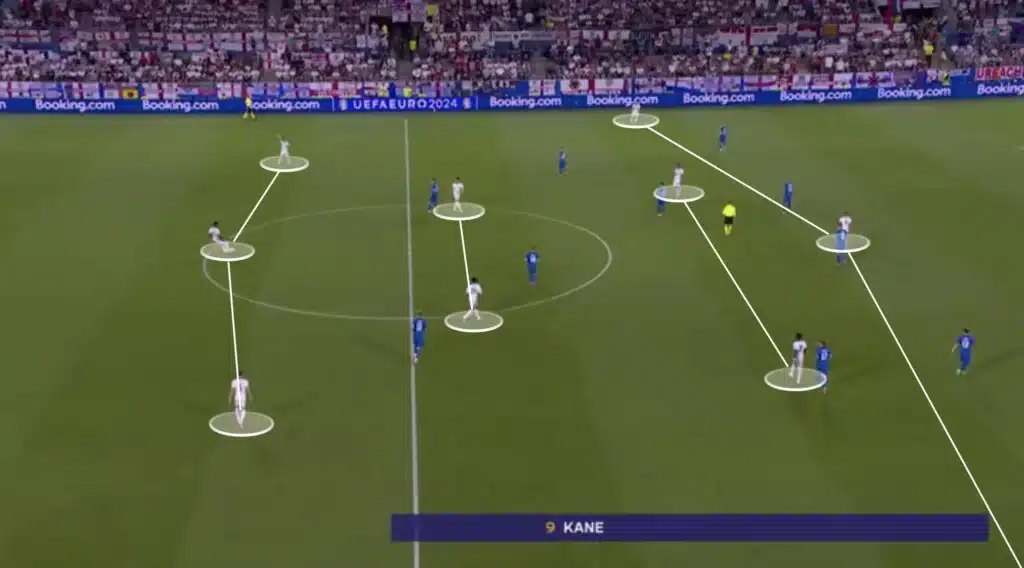
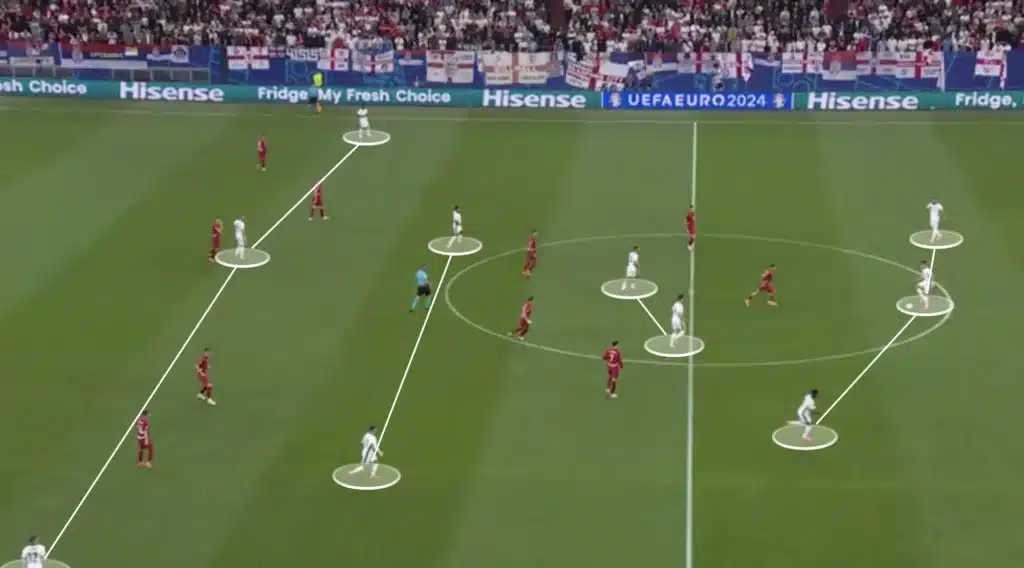
Having four central midfielders(two holding and two attacking) creates more options in the center and less space between the players. Southgate likes this because he prioritizes playing through the middle. He needs one player high and wide to pull apart the backline while the rest create numerical advantages in the midfield areas. This builds good conditions in defensive transitions, allowing more players to press when they lose the ball. Another purpose for keeping many players in the middle is to shorten the distance between them. This shortens the length of the passes, which naturally shortens the time between passes. This means the opposition players will have less time to push up and press, giving the England players more time and control.
They get into the 1-3-2-2-3 formation by pushing one of the fullbacks up as a winger, coming in with the other fullback as a center-back, and having the number-ten and an inverted winger as the two attacking midfielders.
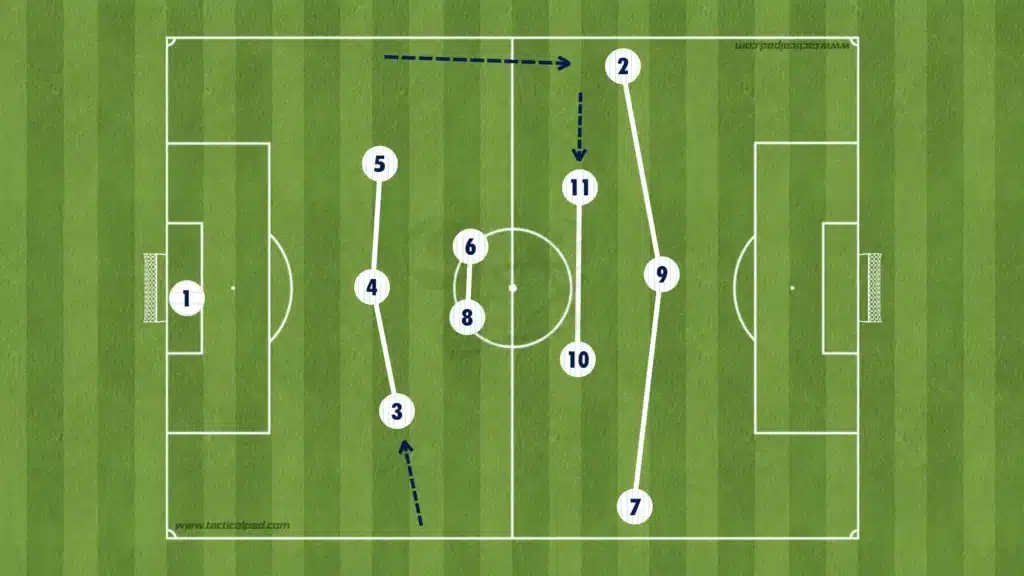
High Backline (Off)
A massive aspect of Southgate’s high build-up is they keep a high backline. This helps in the counterpress because they get closer to the center. Having more players close to the center who can win the ball back makes it difficult for the opposition to do anything when they win possession. Furthermore, the high backline shortens the distance between players, shortening the time and length of the passes and preventing the opposition from pushing up their defense.
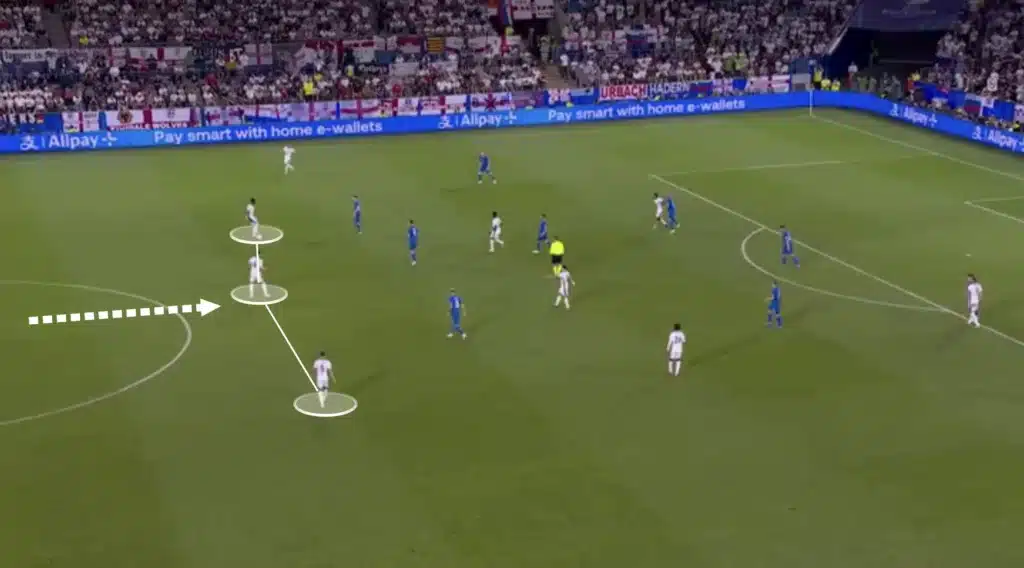
Harry Kane Dropping
Harry Kane, under Gareth Southgate’s tactical system, frequently drops deep during the build-up phase to create numerical superiority in midfield. This movement is pivotal as it allows Kane to act as a link between the midfield and the attack, drawing defenders out of position and creating space for his teammates to exploit.
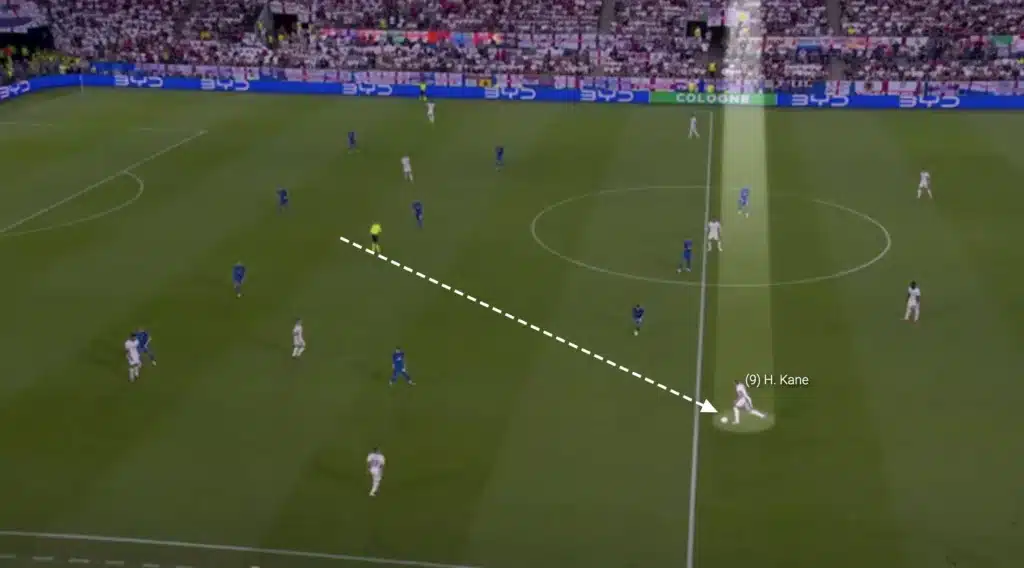
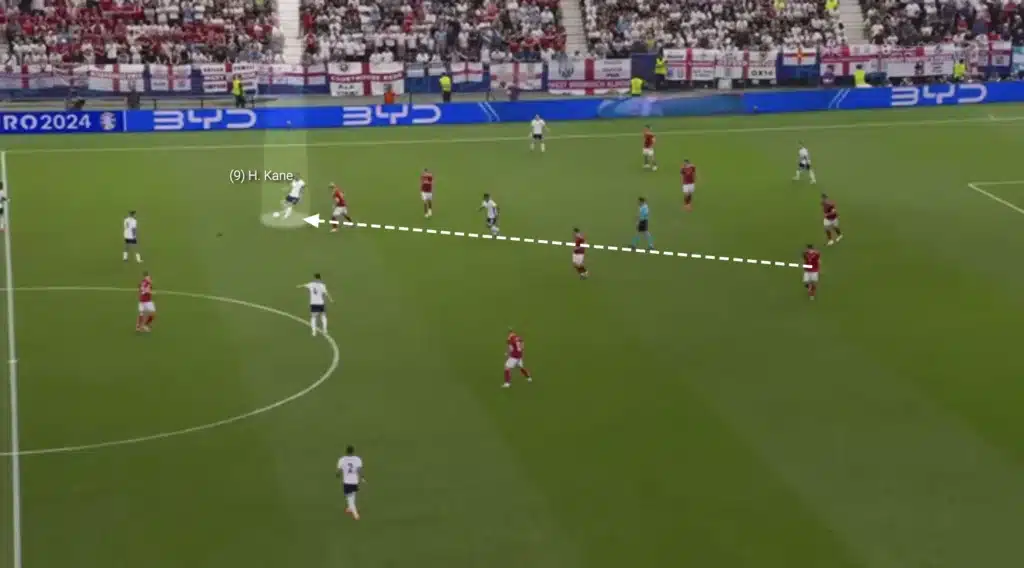
Harry Kane’s ability to drop deep and receive the ball in the build-up play is a crucial aspect of his game. This skill allows him to link up effectively with midfielders and wingers, creating a fluid and dynamic attacking unit. When Kane drops low, he often draws defenders out of position, opening up space for his teammates to exploit. His vision and passing accuracy enable him to distribute the ball efficiently, often initiating dangerous attacking moves. Additionally, Kane’s strength and ball control help him hold up play under pressure, allowing England to maintain possession and build attacks methodically.
Counter-Movements
England frequently use counter-movements to create space in the build-up. For example, when Kane drops, an attacking midfielder will make a run in behind the backline.
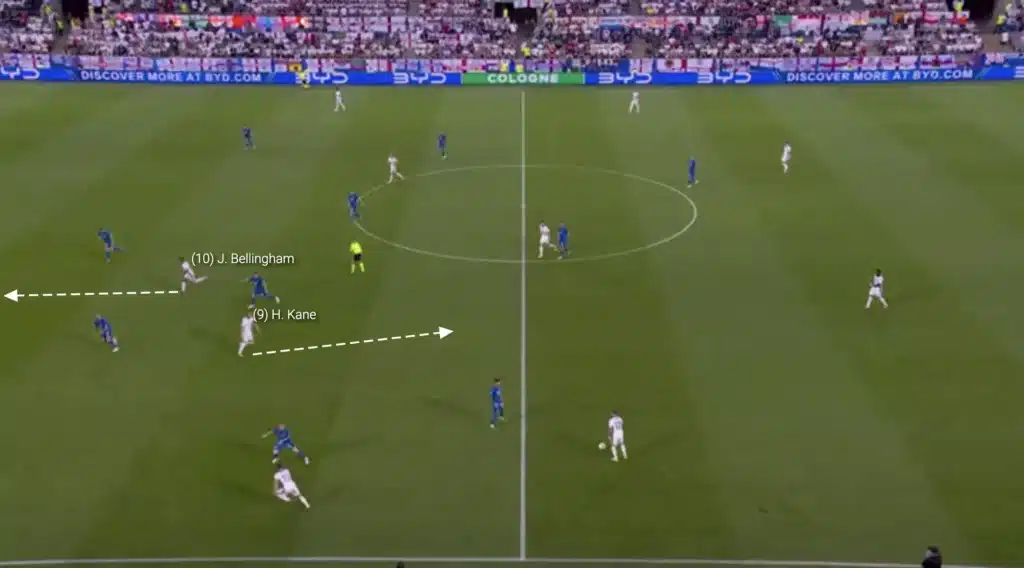
This questions the opposition center-backs. If they push up on Kane, the space for the attacking midfielder opens up, allowing England to play a through-ball in behind. Therefore, many center-backs will stay in their position, which gives Kane the space and time to receive the ball and progress it forward.
England also use a counter-movement between the winger and attacking midfielder. When a wide center-back has the ball, the attacking midfielder will make the run in behind while the winger drops to open the passing lane. This creates a question for the fullback. If he steps out on the winger, the space behind him opens up, allowing the center-back to play a through-ball to the attacking midfielder. However, if he stays inside to cover the run, the ball can be played to the winger, who can turn and attack the defense. Here, the fullback steps out to the dropping winger, allowing the English attacking midfielder to receive the ball in behind.
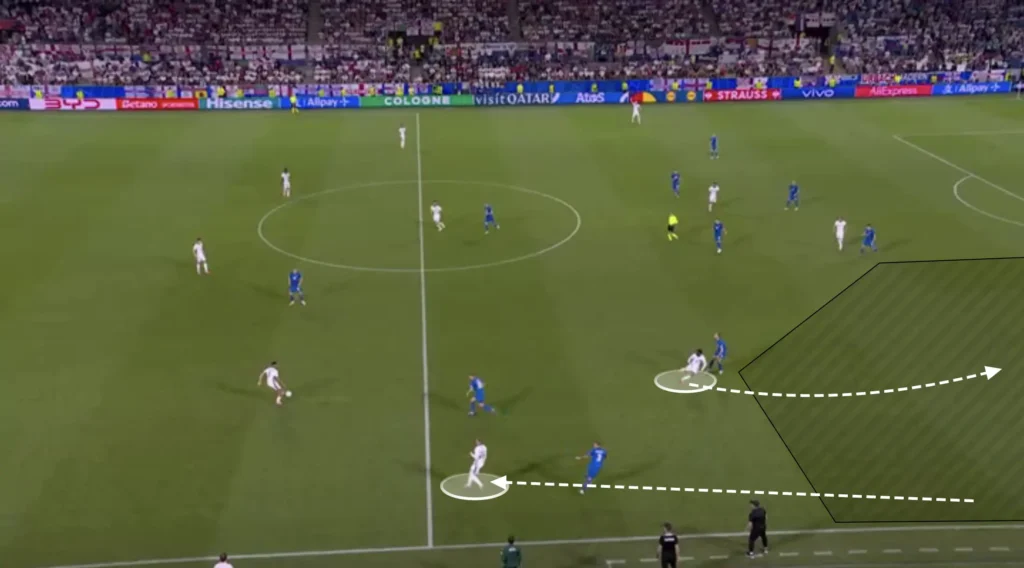
Dropping With Too Many Players?
England’s tactical setup under Gareth Southgate often features several players who like to come deep during the build-up phase. Players such as Harry Kane, Jude Bellingham, and Phil Foden are known for their ability to play deeper and often drop below the opposition’s midfield to receive the ball from the defenders. This gives England a numerical advantage against the opposition’s forward line. The players often drop at the same time, which makes the numerical superiority very big. Here, there are eight England players below the opposition’s midfield, meaning they are 8v1 against Denmark’s striker.
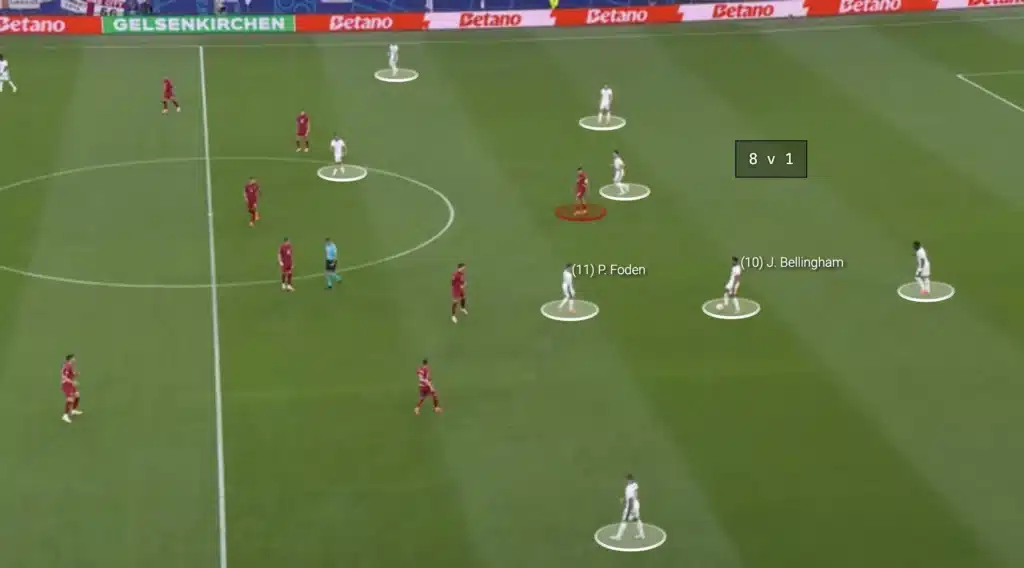
On the one hand, dropping with this many players helps in retaining possession. They will, as established, be in a numerical advantage against the opposition’s first line, allowing them to beat the line and progress the ball forward. On the other hand, it gives England fewer players higher up the pitch. The England players who have not dropped will be in a numerical disadvantage against the opposition defenders and midfielders, which makes it difficult for England to do anything when they beat the first line.
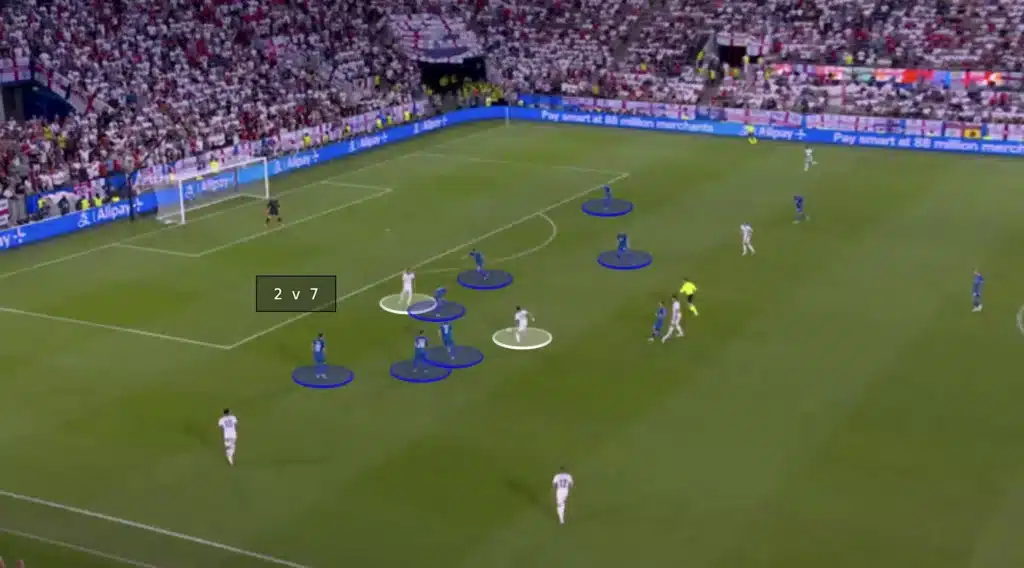
Statistically, England has dominated possession but struggled to create clearcut chances in their games. The reason for this is that they, at times, have seven to eight players low down the pitch who circulate the ball, but only two to three players behind the opposition’s midfield who will create the goalscoring opportunities.
Balls in Behind
The England wingers and attacking midfielders constantly make runs in behind when the defenders or midfielders have the ball, leading to many goalscoring opportunities from dangerous through-balls. This constant threat prevents the opposition from playing with a high backline and closing the space between the lines. Instead, they have to drop the backline and protect the space in behind. This opens the space in front of the backline for the other England midfielders to exploit. Additionally, a player like Trent Alexander-Arnold is amazing at finding these runs with long through-balls.
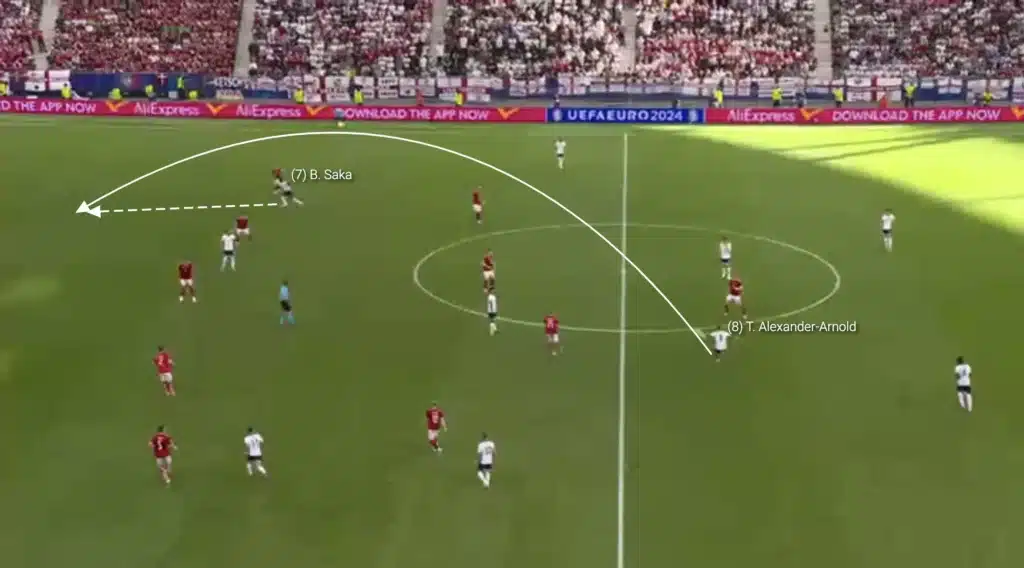
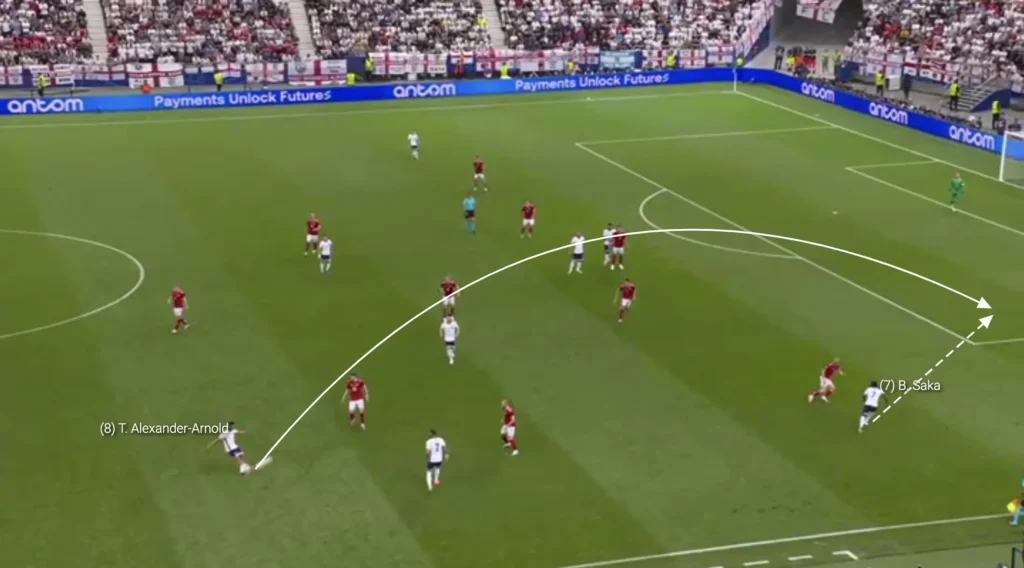
Numerical Advantages
Another aspect of England’s high build-up is their ability to create numerical advantages against the opposition’s defensive line. When the attacking players do not drop at the same time, England’s front five naturally becomes numerically superior against a back four, which they are great at taking advantage of.
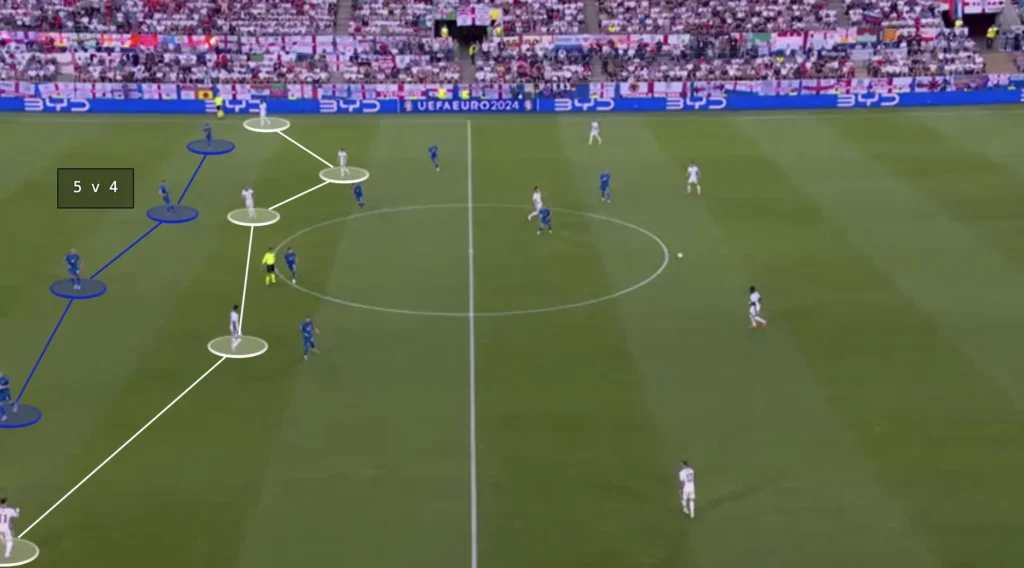
They mainly exploit this by creating 2v1 situations against the opposition fullback. When the defending team is positioned on one side, the weak-side fullback becomes vulnerable to the long switch of play due to the 1v2 against England’s winger and attacking midfielder. The attacking midfielder will make a run in behind, the fullback will follow that run, and the space for the winger out wide will be opened. Southgate’s team often capitalizes on this by getting the ball to the winger and creating many opportunities from 2v1 situations on the wing and in the half-spaces.
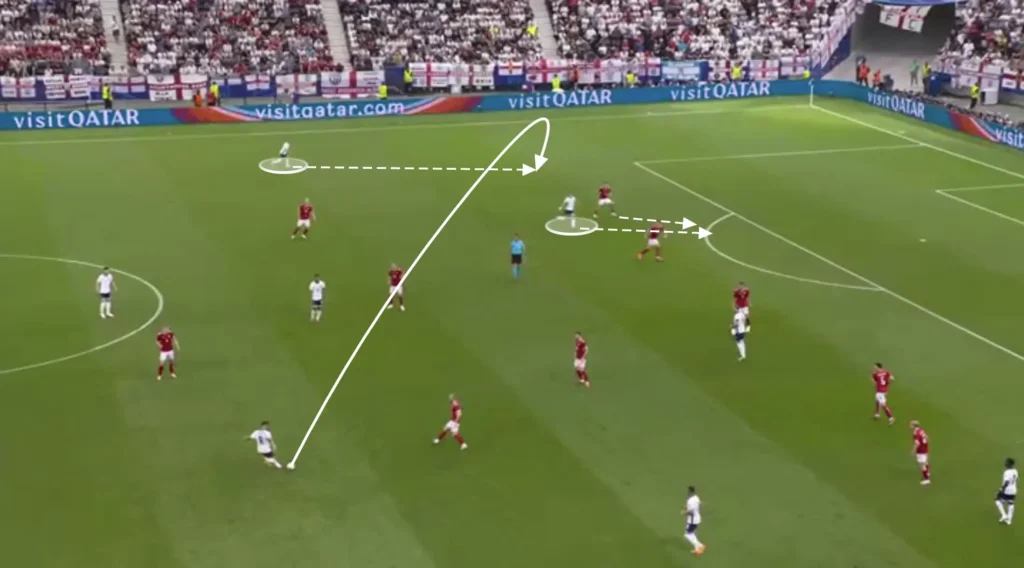
Final Third
Attacking the Half-Space
Southgate’s players usually look to create chances by attacking the space between the opposition center-back and fullback. They primarily do this from the wide areas with underlaps from the attacking midfielders. When the winger receives the ball out wide he will attract the opposition fullback. This opens the space between the fullback and the center-back, which allows the English attacking midfielder to make the underlapping run into this space. The ball can be played to the underlapping player, who can cross the ball into the box or attack his defender in a 1v1 situation.
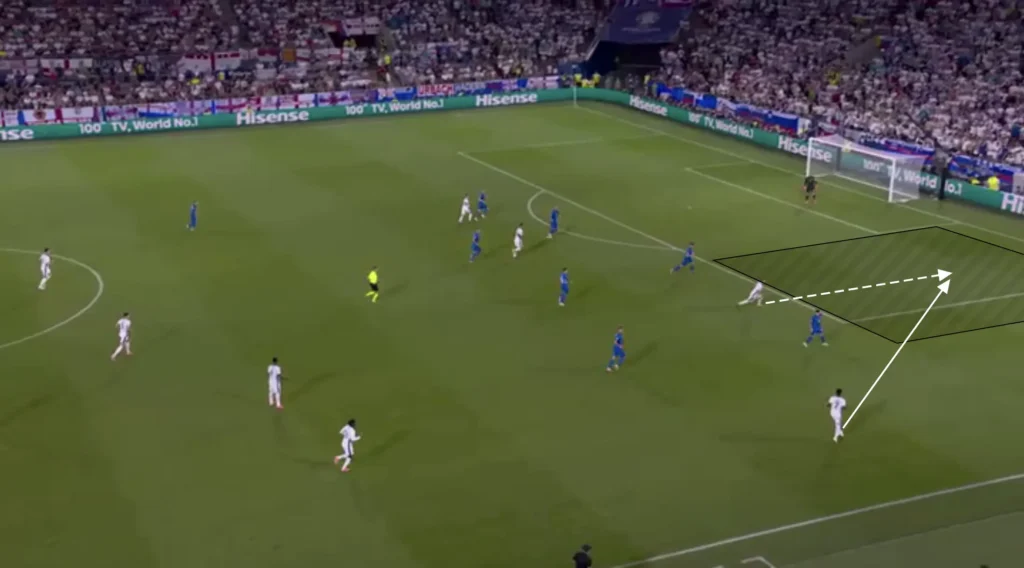
The winger does not have to play the ball to the underlapping player. The run from the attacking midfielder will often drag away an opposition defensive midfielder, which opens the space inside. The winger can take the ball inside and shoot or find a pass to a free player in front of the backline.
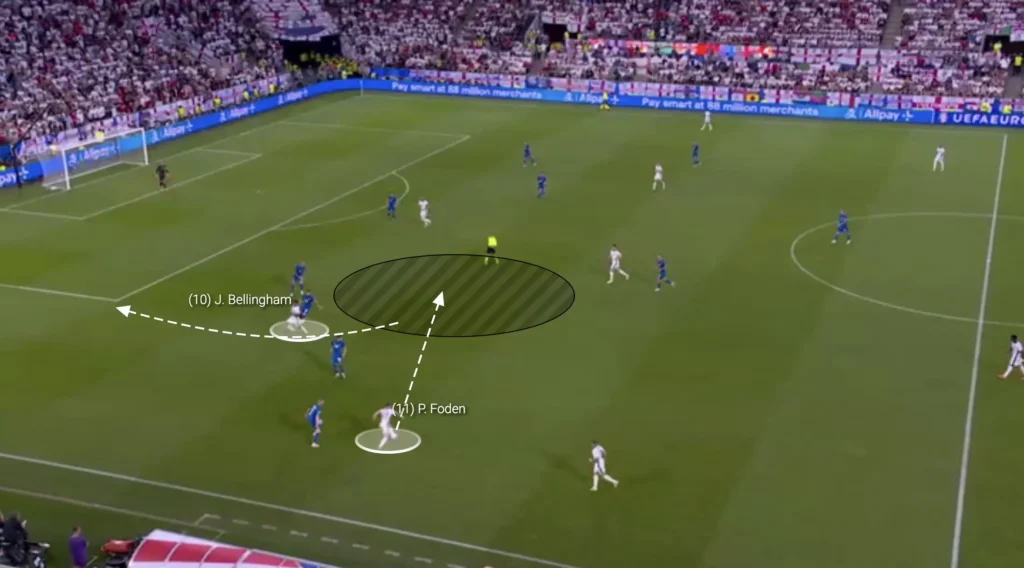
Southgate’s team also exploits the space between the center-back and the fullback by playing through-balls from the midfield or backline into a run from an attacking midfielder.
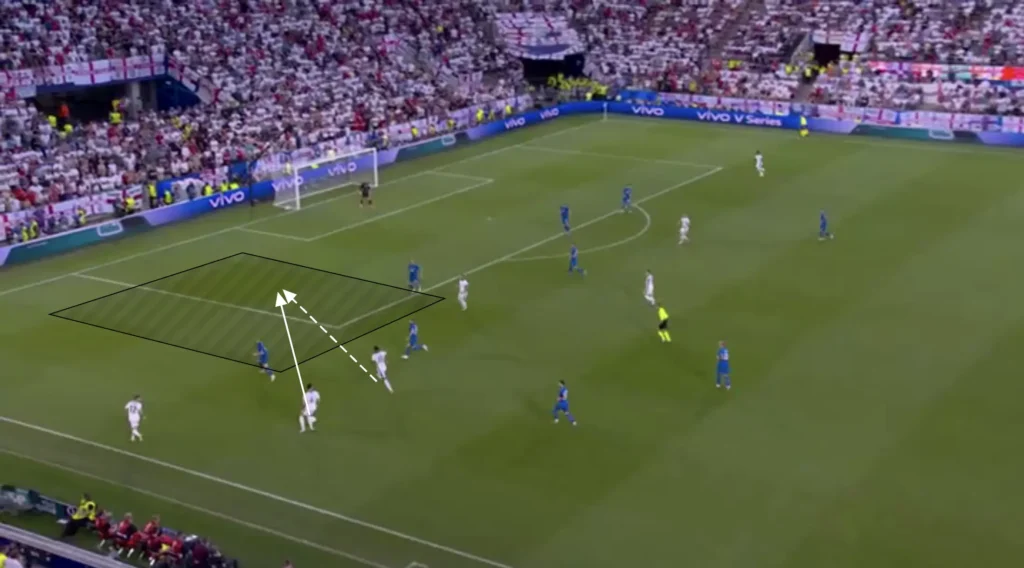
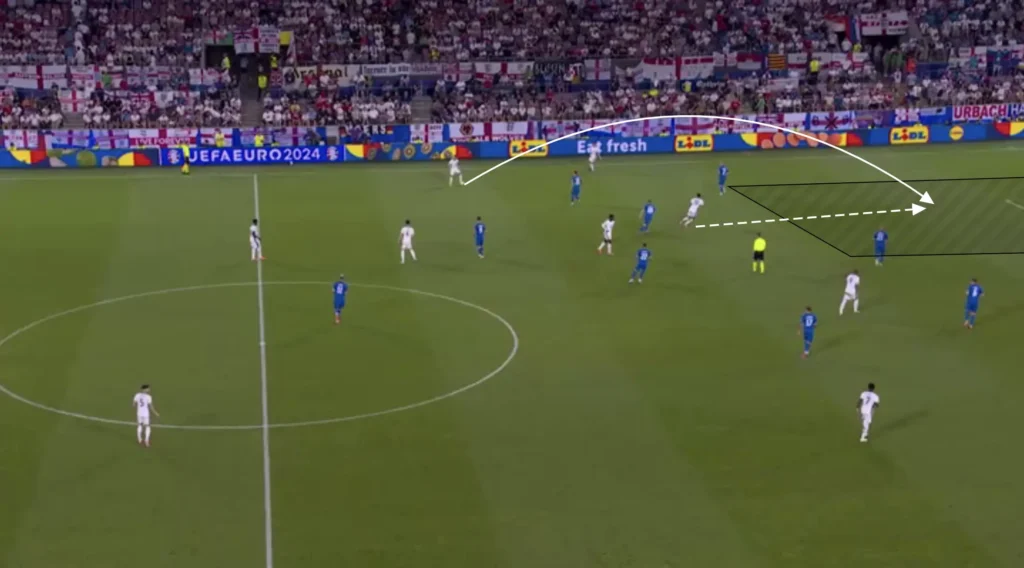
Overlaps
England will also use overlaps to produce opportunities in the final third. When the English winger gets the ball in the half-space, another player quickly makes the overlap, creating a 2v1 against the opposition fullback. If the fullback drops to cover the overlapping run, the winger could cut inside, taking a shot or combining with a midfielder. If the fullback covers the center, the ball can easily be played to the overlapping player, creating a crossing opportunity.
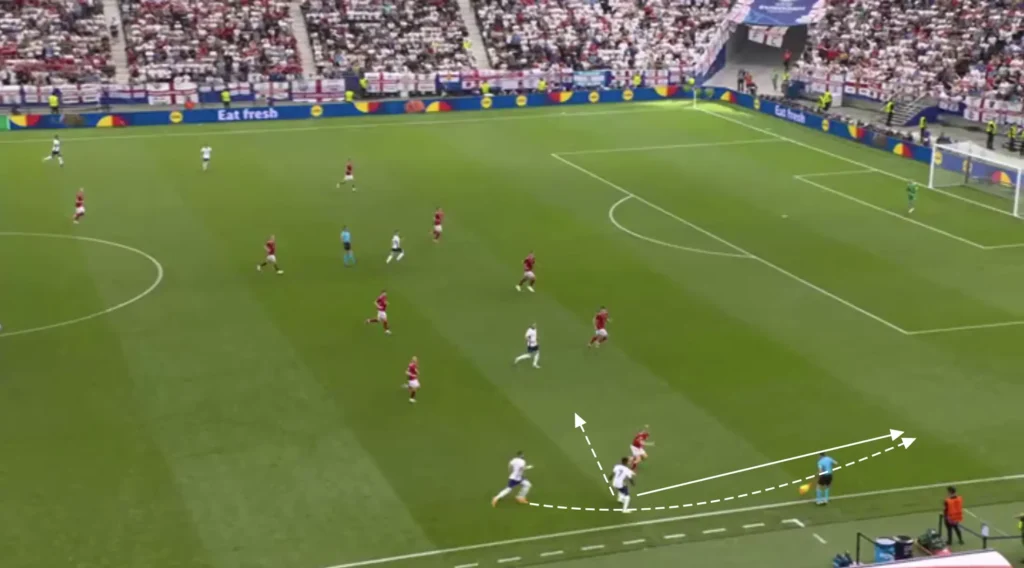
Many Players in the Box
The attacking midfielders and wingers look to make runs into the box when the ball is in the final third, often getting four or five players into these areas to create overloads. The numerical advantages in the box increase the chances of connecting with the cross, as more players present multiple targets for the crosser, making it harder for defenders to mark everyone effectively. Additionally, having multiple players in the box provides options for different types of finishes, whether it’s a header, volley, or a quick tap-in. It also allows for better positioning to react to second balls or rebounds, increasing the likelihood of capitalizing on any defensive errors.
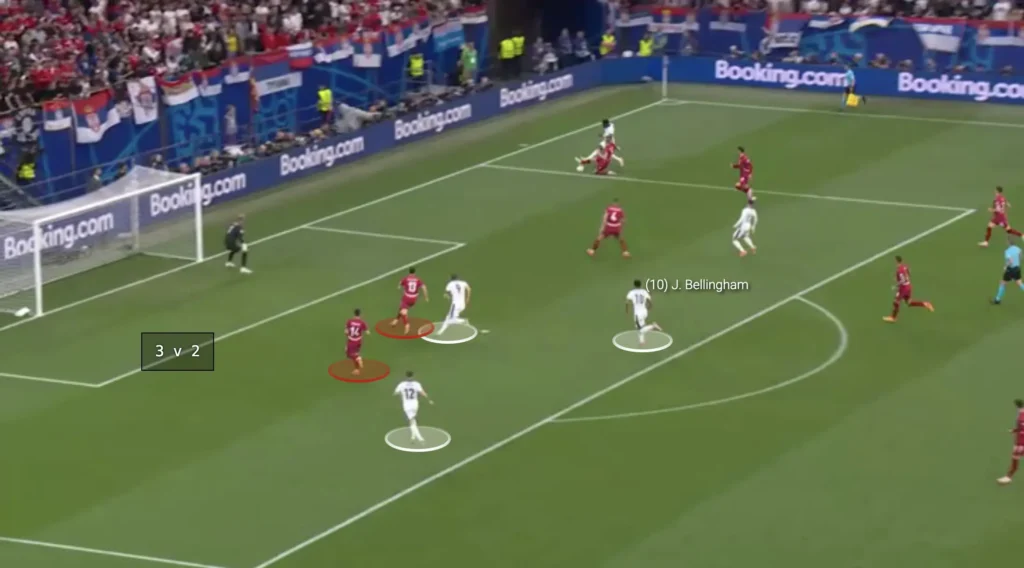
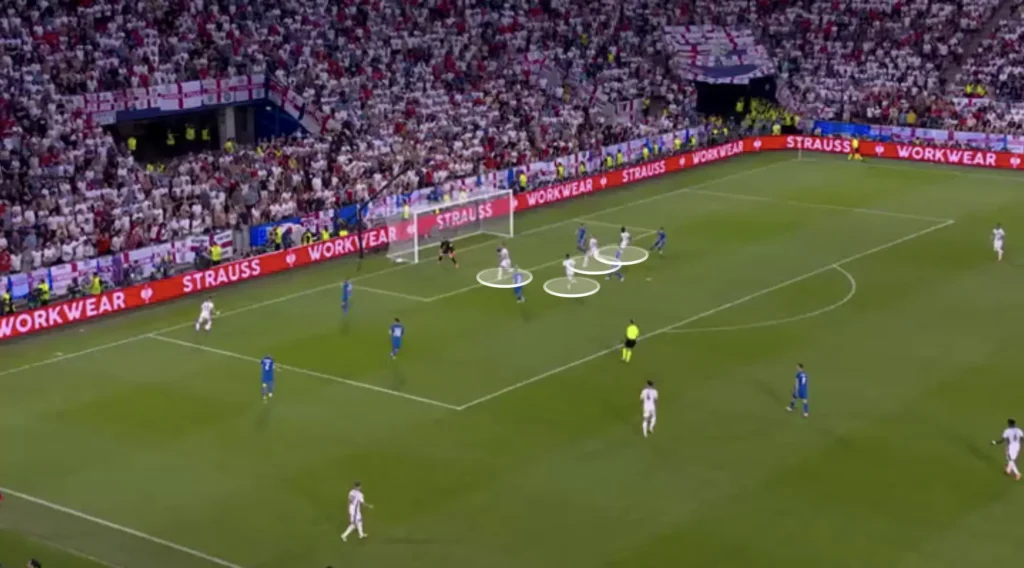
Southgate also positions many players outside the box, ready for the second balls and cut-backs. They always succeed in pushing down the opposition’s defense, which opens the space in front of the backline. The midfielders will often be found in these spaces with cut-backs, and from there, they can shoot or combine with an attacker to create goalscoring opportunities.
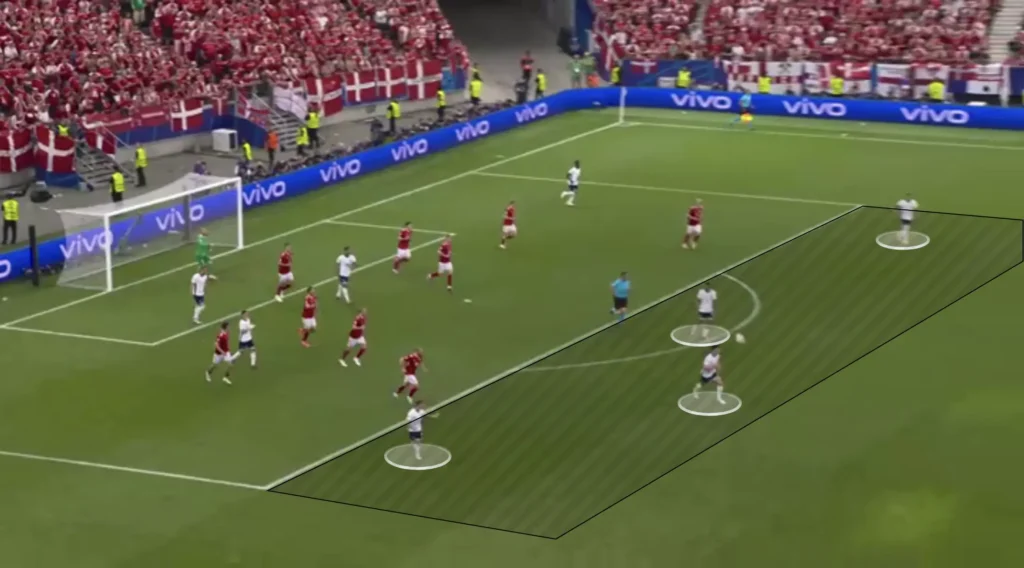
Defending
Southgate’s England uses a 1-4-2-3-1 formation when defending. They look to set up in a mid-block, trying to close the center and force the opposition out wide. Southgate always wants his team to stay extremely compact, prioritizing making the space between the midfield and backline as small as possible.
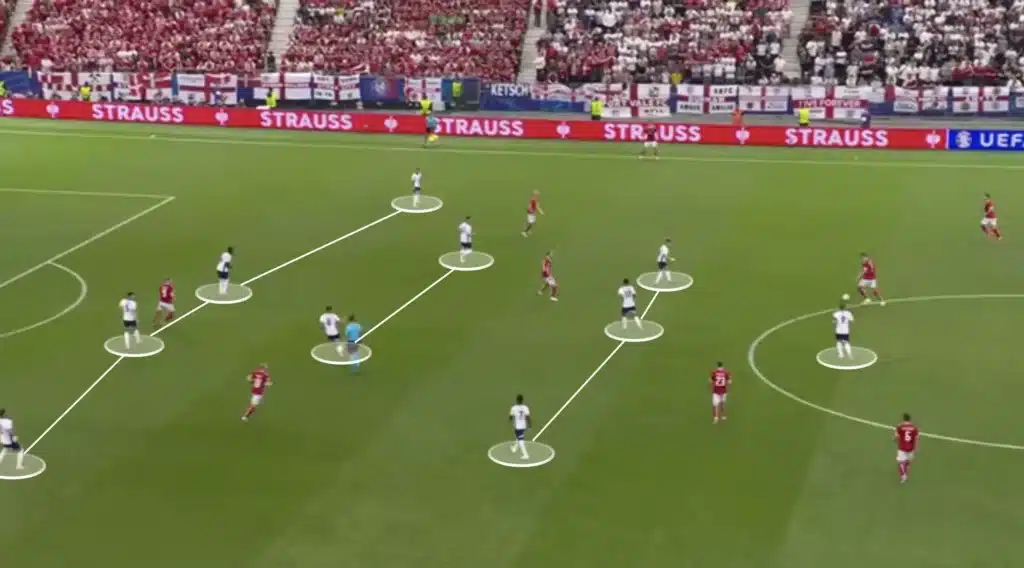
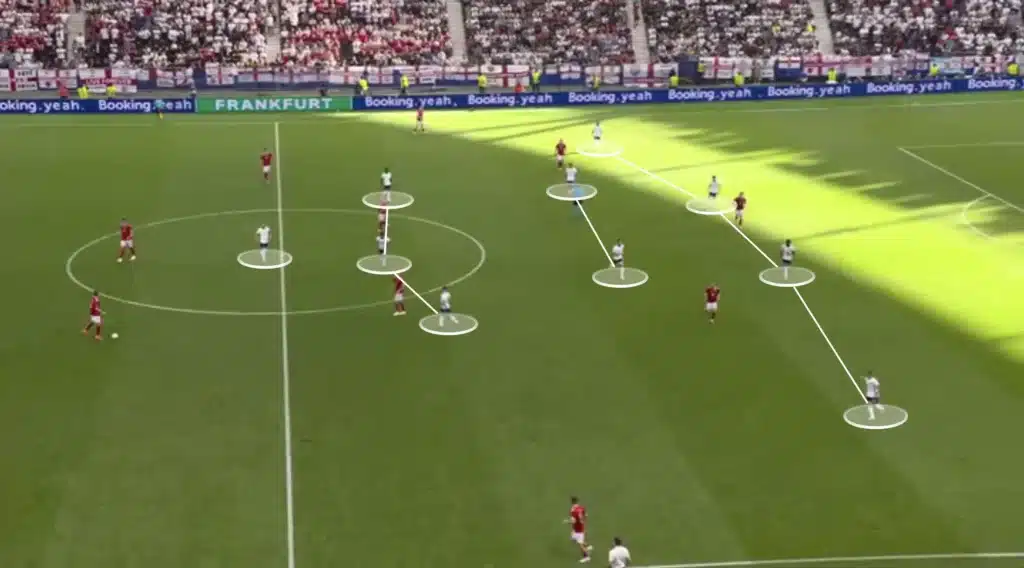
High Backline (Def)
One tool that helps to be compact is to play with a high backline. England do this and usually try to keep the highest line they can without leaving the space behind them too open. Defending with a high backline involves positioning the defensive line closer to the midfield, rather than near the goalkeeper. This tactic compresses the space available for the opposing team to operate, disrupting their build-up play and increasing the chances of winning the ball back quickly.
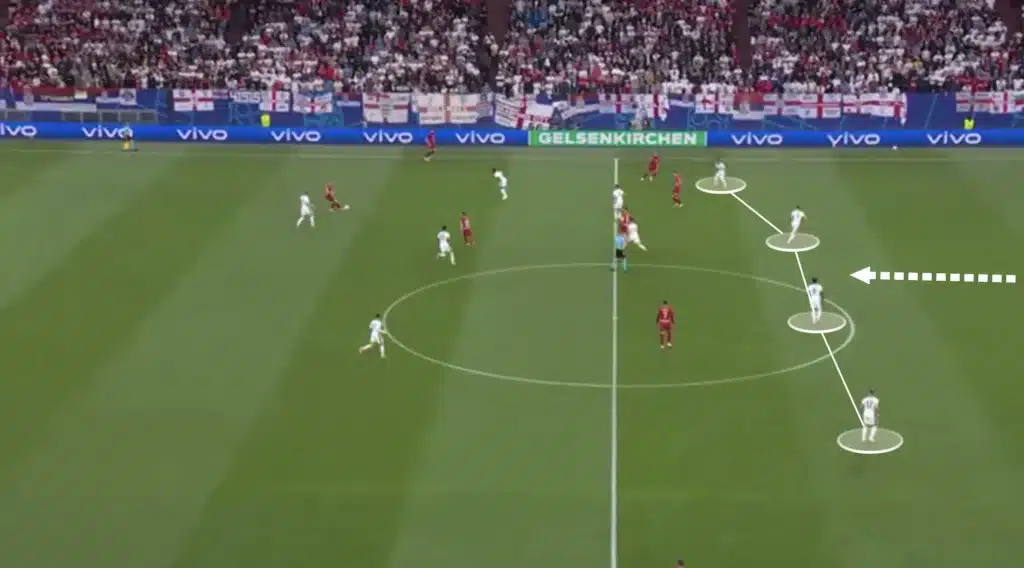
A high backline also allows defenders to support the midfield more effectively, creating numerical superiority in central areas and facilitating quicker transitions from defense to attack. However, it requires defenders with good pace and positional awareness to deal with long balls and prevent opposing attackers from exploiting the space behind. This approach demands constant communication and coordination among the backline to maintain a cohesive and effective defensive structure.
Everyone must be in the same line when defending with a high backline to maintain an effective offside trap, ensure cohesive coverage, and reduce gaps that attackers can exploit. A well-aligned defensive line makes it easier to catch opposing forwards offside, preventing them from receiving the ball in dangerous positions.
Squeezing the Pitch
Southgate wants his team to squeeze the pitch when defending. This means constantly pushing the team up as much as possible. Every time the opponent plays a slow, sideways pass or a back pass, England’s first line of pressure pushes up, with the rest of the team following to stay compact. When the next pass comes, they push up even more, forcing the opponent back even more. They do this because it pushes the opponent further away from the England goal, making it harder to create chances.
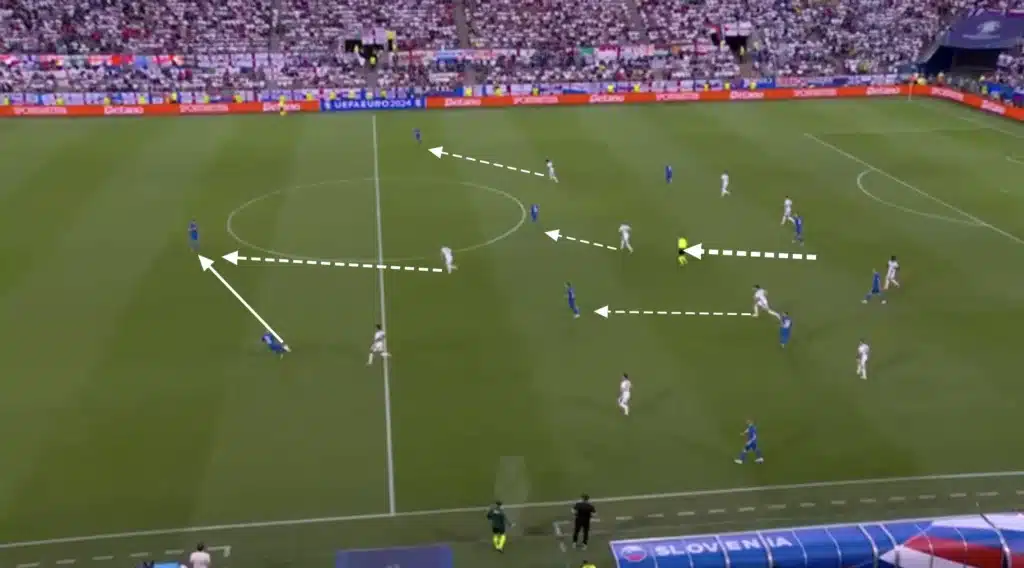
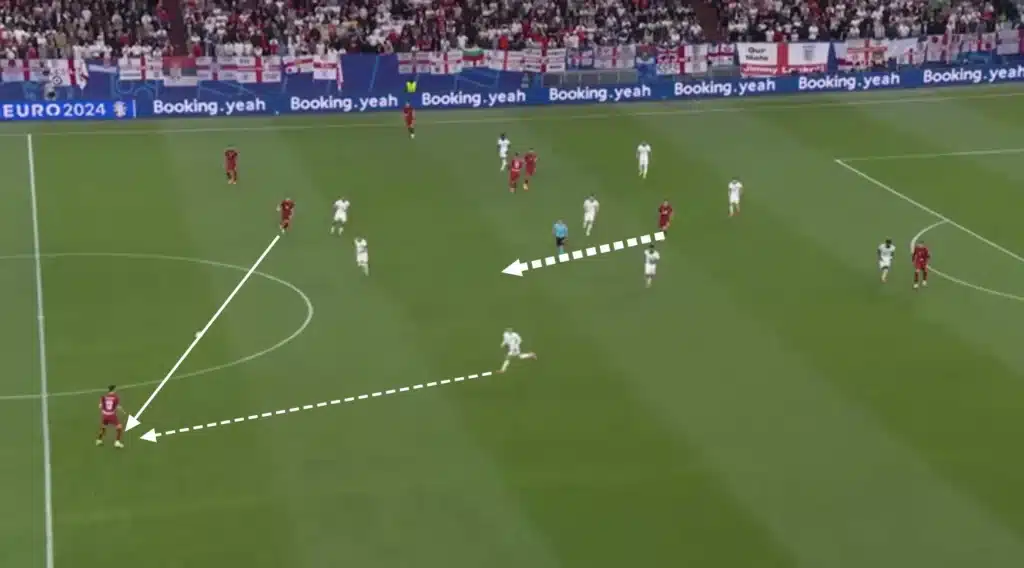
Transitions
Defensive Transitions
Positioning many players centrally, creating a numerical advantage in the midfield, creates good conditions in defensive transitions. Many players close to the ball after losing possession means that many players can work towards regaining possession. Southgate’s players are also very aggressive in the first seconds after losing the ball. The three or four players closest will immediately jump on the opposition player with the ball and close the distance to cut off any passing lanes. England, therefore, often regain possession immediately after losing it.
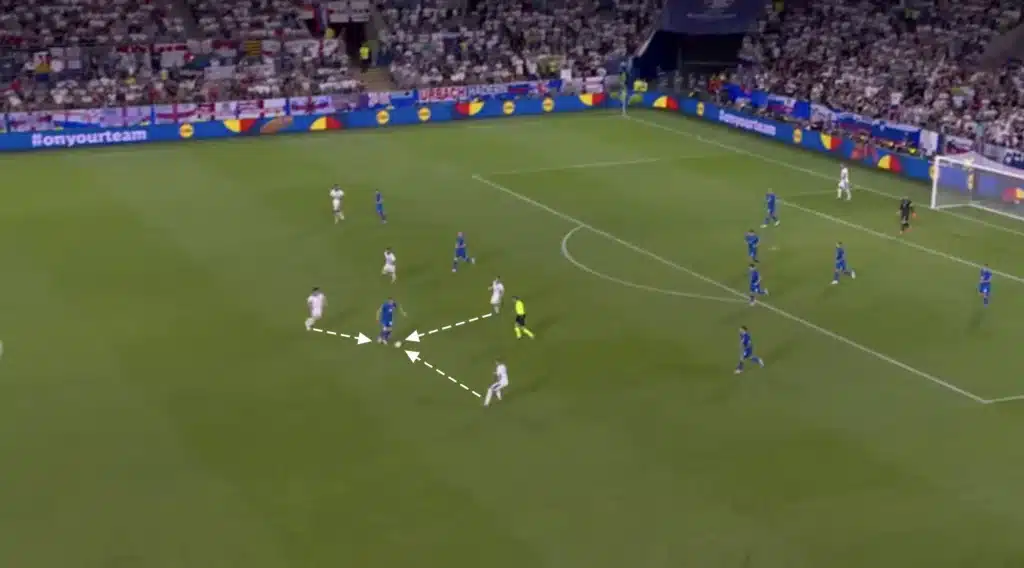
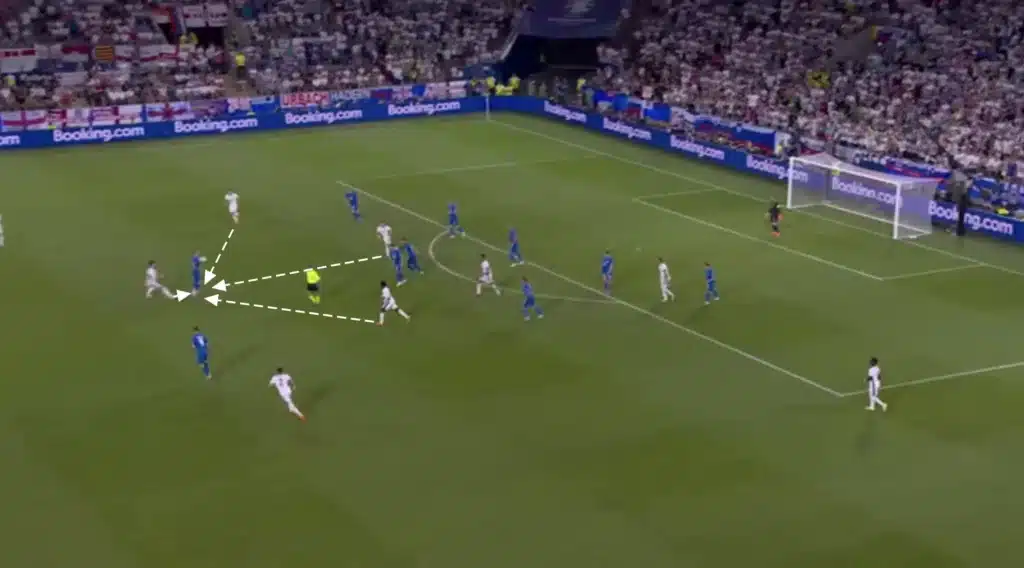
Offensive Transitions
Southgate also wants his team to counterattack in their offensive transitions. Players like Jude Bellingham and Bukayo Saka are at their best when they can use their speed and power to get past the defenders. England, therefore, look to counterattack with a high tempo, often attacking the spaces between the center-backs and fullbacks. Additionally, keeping many players centrally while defending enables them to incorporate more players into the counterattacks.
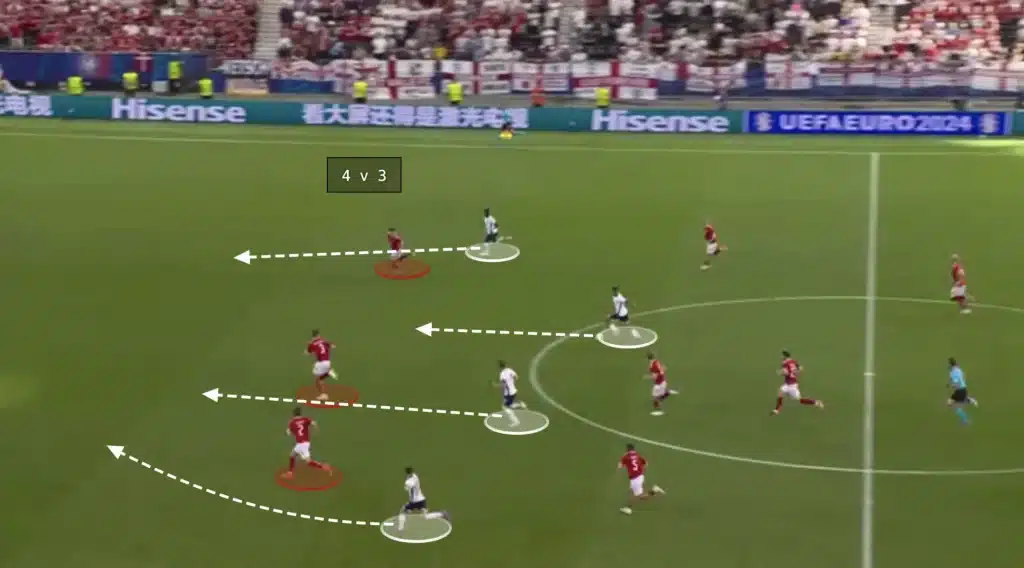
Final Thoughts
In conclusion, Gareth Southgate’s tactical approach with the England national team exemplifies a modern and adaptable style of play. Through his tenure, Southgate has skillfully balanced defensive solidity with attacking creativity, utilizing formations and strategies that maximize his squad’s strengths. His emphasis on youth development and versatility has also been instrumental in creating a dynamic and cohesive team.
Southgate’s ability to implement a flexible tactical system has allowed England to consistently compete at the highest levels of international football, reaching the latter stages of major tournaments. His focus on building a strong team ethos, combined with a clear tactical vision, has positioned England as a formidable force on the global stage. As the team continues to evolve under his leadership, the tactical foundations laid by Southgate will undoubtedly play a crucial role in their future successes.
